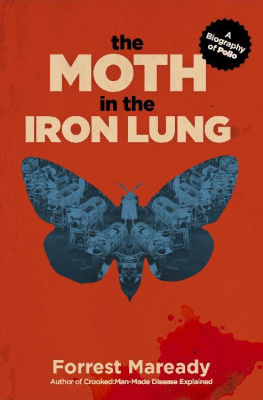Forrest Maready - The Moth in the Iron Lung: A Biography of Polio
Here you can read online Forrest Maready - The Moth in the Iron Lung: A Biography of Polio full text of the book (entire story) in english for free. Download pdf and epub, get meaning, cover and reviews about this ebook. year: 2018, genre: Detective and thriller. Description of the work, (preface) as well as reviews are available. Best literature library LitArk.com created for fans of good reading and offers a wide selection of genres:
Romance novel
Science fiction
Adventure
Detective
Science
History
Home and family
Prose
Art
Politics
Computer
Non-fiction
Religion
Business
Children
Humor
Choose a favorite category and find really read worthwhile books. Enjoy immersion in the world of imagination, feel the emotions of the characters or learn something new for yourself, make an fascinating discovery.
- Book:The Moth in the Iron Lung: A Biography of Polio
- Author:
- Genre:
- Year:2018
- Rating:3 / 5
- Favourites:Add to favourites
- Your mark:
- 60
- 1
- 2
- 3
- 4
- 5
The Moth in the Iron Lung: A Biography of Polio: summary, description and annotation
We offer to read an annotation, description, summary or preface (depends on what the author of the book "The Moth in the Iron Lung: A Biography of Polio" wrote himself). If you haven't found the necessary information about the book — write in the comments, we will try to find it.
Forrest Maready: author's other books
Who wrote The Moth in the Iron Lung: A Biography of Polio? Find out the surname, the name of the author of the book and a list of all author's works by series.
The Moth in the Iron Lung: A Biography of Polio — read online for free the complete book (whole text) full work
Below is the text of the book, divided by pages. System saving the place of the last page read, allows you to conveniently read the book "The Moth in the Iron Lung: A Biography of Polio" online for free, without having to search again every time where you left off. Put a bookmark, and you can go to the page where you finished reading at any time.
Font size:
Interval:
Bookmark:

A Biography of Polio.
by Forrest Maready
Besides historical references, the names, places, and accounts mentioned in this book are used anonymously. Any resemblance to actual persons, living or dead, is entirely coincidental.
Text copyright 2018 by Forrest Maready
Cover Design 2018 by Forrest Maready
Cover typography 2018 by Forrest Maready

All rights reserved. Published in the United States by Feels Like Fire, an imprint of Feels Like Fire.
ISBN 978-1717583673
Printed in the United States of America
Also by Forrest Maready:
Crooked:Man-made Disease Explained, 2018
My Incredible Opinion Vol. 1, 2016
My Incredible Opinion Vol. 2, 2017
Massa Damnata, 2017

I breathe.
Barret Hoyt, after being placed in an iron lung.


Of the many iron lung photographs to come out of the 1930s and 40s, one stands out as especially haunting. It looks to be a bedroom. In the background sits a small dresser topped with a doily, family pictures, and a perfume atomizer. A large sheet covers the right side, presumably to hide the bedding, which has been leaned against the wall to make room for what lies in the center: a gritty, cobbled together iron lung, made from spare parts one might find in any auto garage. The central component is a discarded 10 gallon drum of Veedol Motor Oil, lying on its side across two chairs. A makeshift bellows has been attached to an electric motor in an attempt to push air in and out of the cylinder. The whole affair is bolted down into an otherwise unblemished wooden floora subtle but stark indicator of the desperation involved in this scene.
There are many pictures throughout American history of men enjoying the results of their clever time-saving, work-reducing inventions. This picture is different. A manlikely the inventorsits beside the contraption, his hands covered in grease, looking tenderly at the person inhabiting the barrel. He is presumably a new father and is desperately trying to save his childs life. Inside the Veedol barrel lies an infant, its tiny headbarely half the size of his grease-covered handthe only part of its body that is visible.
Whether this child was suffering from polio, or simply the effects of a premature birth, we can only guess. Whatever it was, in the 1900s peopleparticularly childrenwere being stricken down with paralysis, and mothers, fathers, doctors, and nurses were doing anything they could to save them. In the past, a sick child could be held, rocked, or given powders or syrup recommended by the doctor. In the paralytic polio era, none of these seemed to workthere was nothing one could do besides sit and wait.
During the peak of the polio epidemic in the 1950s, there were 1,157 iron lungs in operation in the United States. Although their use was limited, the psychological impact they have had on the publics perception of polio has been immense. These gargantuan iron coffins which made the humans insidewith the exception of their headinvisible have shaped our knowledge about this mysterious disease like nothing else. Most people have heard of polio and have some idea what its symptoms are. Many people have seen pictures of otherwise healthy looking children, their legs and feet bound up in casts and splints to help them walk. But nearly everyone has burned into their mind a few black and white images of disembodied humans, floating inside iron sarcophaguses as if they were part of some giant magic showtheir bodies waiting to be cut in half and put back together again.
For many inside the iron lungs, the paralysis would disappear after several weeks or months, and they might return to some semblance of a normal life. But for the rest of humanity, the images of victims stuck inside the iron lung would forever change the way they thought about disease and medicine.
* * *
There is another story about polio that is not often told. The black and white images of people in iron lungs are often as far as many peoples recollections will take them. It was a terrible disease with a terrible diagnosis and an even more terrible treatment. Many books have been written about itspecifically, the fear and panic that overtook much of the world in the mid 1900s and the scientists who completed their heroic quest for a vaccine. Its a tale that any human would enjoy hearingthe conquest of a dreaded disease by the unrelenting perseverance and cunning of our best and brightest minds. David Oshinskys Polio, An American Story, won the 2006 Pulitzer Prize for history. Many other books on the subject are similarly appreciated. The polio vaccine sits at the top of many lists ranking the greatest medical achievements in human history and the decades-long account of its creation makes for riveting drama.
But lost amidst the jubilation of Salks injected polio vaccine in 1955 and Sabins oral vaccine in 1961 is an intriguing riddlea question whose answer is fascinating to those who are deeply curious about polio: What happened before the vaccine? What caused a previously innocuous virus to begin paralyzing peopleseemingly randomly at first in the early 1800s, then more frequently in epidemic form in the late 1800s and early 1900s? For all the fanfare of victory over the dreaded disease, few seem interested in finding out why the vaccine was necessary at all.
Besides a few isolated cases of paralysis that appear sporadically within the medical literature, polio was completely unknown to most physiciansso rare, in fact, that doctors of New York City in 1916 would need to attend classes to learn how to recognize its symptoms, as most of them had never seen a single case themselves. In 1932, an international group trying to make sense of polios rise confessed, No circumstance in the history of poliomyelitis is so baffling as its change, during the last two decades of the nineteenth century, from a sporadic to an epidemic disease.
The increasingly large outbreaks of the illness were not the only concern. The selective nature of those it targeted baffled those who studied it. In 1943, years before he would perfect the oral polio vaccine, a perplexed Albert Sabin wrote a colleague from the Philippines:
The only mystery as I see it, is why the incidence is so much higher among [our] troops than among the natives.
Sabin had temporarily halted his polio work and joined the U.S. Army in conducting infectious disease research abroad during the second World War. The paralysis that had gripped young children every summer in the United States (and a few other first world countries) seemed remarkably absent elsewheremore confusing because local Filipinos tested positive for poliovirus while their incidence of paralysis was nearly zero. It was a pattern that vexes researchers to this daywhere disease and death often tracked the abysmal sanitation and nutrition of the poor, polio seemed to affect the rich and well-to-do. The better the sanitation, the more frequently paralysis would occur.
Font size:
Interval:
Bookmark:
Similar books «The Moth in the Iron Lung: A Biography of Polio»
Look at similar books to The Moth in the Iron Lung: A Biography of Polio. We have selected literature similar in name and meaning in the hope of providing readers with more options to find new, interesting, not yet read works.
Discussion, reviews of the book The Moth in the Iron Lung: A Biography of Polio and just readers' own opinions. Leave your comments, write what you think about the work, its meaning or the main characters. Specify what exactly you liked and what you didn't like, and why you think so.









